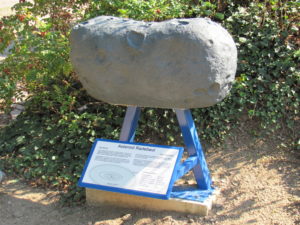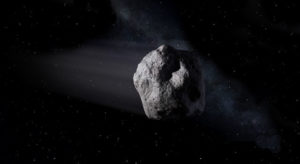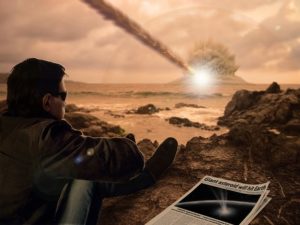Remember Armageddon? Regardless of whether you loved that movie for its cheesiness or hated it for the not-so-hard science, the film gets one thing right: Asteroids pass by Earth all the time. One such flying space rock made the news on October 31, another on November 6 for so-called near misses.
Not to worry, though. Most asteroids would never cause the level of catastrophic damage that Michael Bay and Roland Emmerich dream of, says Paul Chodas, manager of the Center for NEO Studies at NASA JPL. Recursor spoke with Chodas about NASA’s new Scout software, which targets NEOs (near-Earth objects) for study.

Radebeul Modell Asteroid, Jbergner, 2010. CC Attribution-Share Alike 4.0 International license.
“The asteroid that passed by on October 31 was about 30 feet in size, not really ‘large,’” says Chodas. “The media made a bigger deal out of it than was warranted. This asteroid was fairly routine and was called out as an example of how our Scout software identifies close approaches shortly after an object is discovered. In this case, the close approach was at about 500,000 km, well beyond the Moon’s orbit, but which is a fairly close passage astronomically speaking. But not particularly unusual: asteroids of that size are numerous enough that we have a few such close approaches every week.”
Just how many is “a few?” According to Chodas, “We are on track to find roughly 1,600 NEAs this year.” That’s a lot of rocks.
NEOs: Great for Advancing Astronomy
Though asteroids may not seem sexy compared to, say, a trip to Mars, astronomers care about NEAs for several reasons — including the sort of collision course that Bruce Willis and Ben Affleck launched into space to prevent.
Says Chodas, “This is a very unlikely scenario, but the consequences of an asteroid impact could be enormous. If we find that asteroid many orbits before the potential impact, we have a chance to avert the collision. For example, we have the technology to deflect it, given enough warning time.” Ok, we’ll give Michael Bay a pass.

Artist’s concept of a near-Earth object. Image credit: NASA/JPL-Caltech
But there are other, better reasons to study near-Earth objects, including glimpses into how the universe works. Says Chodas, “Investigating NEAs can help scientists understand the origins of the Solar System, not only through understanding the composition of the primordial material, but also how the planets and asteroids formed in the first place.”
If you’re into searching for signs of extraterrestrial life, near-Earth asteroids provide great fodder for analysis. And they may also offer needed resources when astronauts perform longer-term space exploration.
“We would like to understand the prevalence of NEAs which contain volatiles (such as oxygen and water) and other organic compounds,” says Chodas. “Someday we might be able to extract resources from asteroids, which could be used as consumables as explorers expand into the Solar System.”
That makes the NASA Scout software invalauble. “The exciting thing about Scout,” says Chodas, “is that it provides an early alert to an upcoming close approach. This allows astronomers to plan observations of the new object before it passes by and often becomes unobservable. Without that alert, astronomers often don’t have enough time to schedule their observations, and we wouldn’t have an opportunity to characterize the new object.”

“Asteroid Impact” Dmytro Ivashchenko, 10 Feb 2010. CC Attribution-Share Alike 4.0 International license